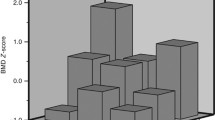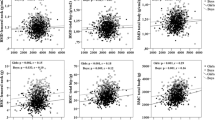Abstract
Introduction
A number of studies have reported that pre-pregnancy overweight status is associated with offspring obesity, yet only a few studies have examined pre-pregnancy underweight status as it associates with offspring health. The aim of the present study was to assess the effect of pre-pregnancy underweight status in a mother on health outcomes in her offspring. To this end, the primary outcome examined in the present study was underweight status in the offspring, with a secondary outcome of offspring low bone mass.
Materials and methods
The present retrospective cohort study, conducted from 2008 to 2011, targeted a source population of all students registered as fifth-graders at three public elementary schools in Hamamatsu and Fukuroi cities. Maternal height and weight before and after pregnancy and offspring weight and height at birth were obtained from the Maternal and Child Health Handbook. Offspring weight and height at age 10 years were measured using standard procedures. Offspring total body less head (TBLH) bone mineral content (BMC) was determined with a dual-energy X-ray absorptiometry scanner.
Results
Pre-pregnancy underweight status was found to be associated with an increased risk of an underweight status in female offspring (OR = 2.88, 95% CI 1.06–7.81). Offspring TBLH BMC in the underweight mother group was significantly lower than that in the non-underweight mother group.
Conclusions
We determined that pre-pregnancy underweight status was more likely to lead to an underweight status and low TBLH BMC in school-aged offspring.
Similar content being viewed by others
References
Collaboration NCDRF (2016) Trends in adult body-mass index in 200 countries from 1975 to 2014: a pooled analysis of 1698 population-based measurement studies with 19.2 million participants. Lancet 387:1377–1396. https://doi.org/10.1016/S0140-6736(16)30054-X
Takimoto H, Yoshiike N, Kaneda F, Yoshita K (2004) Thinness among young Japanese women. Am J Public Health 94:1592–1595
Inokuchi M, Matsuo N, Takayama JI, Hasegawa T (2014) Trends in thin body stature among Japanese male adolescents, 2003–2012. Ann Hum Biol 41:277–281. https://doi.org/10.3109/03014460.2013.856938
Inokuchi M, Matsuo N, Takayama JI, Hasegawa T (2015) Trends in thin body stature among Japanese female adolescents, 2003–2012. Ann Hum Biol 42:533–537. https://doi.org/10.3109/03014460.2014.975280
Okubo H, Murakami K, Masayasu S, Sasaki S (2018) The relationship of eating rate and degree of chewing to body weight status among preschool children in Japan: a nationwide cross-sectional study. Nutrients. https://doi.org/10.3390/nu11010064
Rafique N, Al-Sheikh MH (2018) Prevalence of primary dysmenorrhea and its relationship with body mass index. J Obstet Gynaecol Res 44:1773–1778. https://doi.org/10.1111/jog.13697
Jiang M, Zou Y, Xin Q, Cai Y, Wang Y, Qin X, Ma D (2019) Dose-response relationship between body mass index and risks of all-cause mortality and disability among the elderly: a systematic review and meta-analysis. Clin Nutr 38:1511–1523. https://doi.org/10.1016/j.clnu.2018.07.021
Javaid MK, Eriksson JG, Kajantie E, Forsen T, Osmond C, Barker DJ, Cooper C (2011) Growth in childhood predicts hip fracture risk in later life. Osteoporos Int 22:69–73. https://doi.org/10.1007/s00198-010-1224-3
Ferrari S, Rizzoli R, Slosman D, Bonjour JP (1998) Familial resemblance for bone mineral mass is expressed before puberty. J Clin Endocrinol Metab 83:358–361. https://doi.org/10.1210/jcem.83.2.4583
Perez-Lopez FR, Chedraui P, Cuadros-Lopez JL (2010) Bone mass gain during puberty and adolescence: deconstructing gender characteristics. Curr Med Chem 17:453–466
Matkovic V (1992) Calcium intake and peak bone mass. N Engl J Med 327:119–120. https://doi.org/10.1056/NEJM199207093270210
Weaver CM, Gordon CM, Janz KF, Kalkwarf HJ, Lappe JM, Lewis R, O'Karma M, Wallace TC, Zemel BS (2016) The national osteoporosis foundation’s position statement on peak bone mass development and lifestyle factors: a systematic review and implementation recommendations. Osteoporos Int 27:1281–1386. https://doi.org/10.1007/s00198-015-3440-3
Ambroszkiewicz J, Gajewska J, Rowicka G, Klemarczyk W, Chelchowska M (2018) Assessment of biochemical bone turnover markers and bone mineral density in thin and normal-weight children. Cartilage 9:255–262. https://doi.org/10.1177/1947603516686145
Baxter-Jones AD, Faulkner RA, Forwood MR, Mirwald RL, Bailey DA (2011) Bone mineral accrual from 8 to 30 years of age: an estimation of peak bone mass. J Bone Miner Res 26:1729–1739. https://doi.org/10.1002/jbmr.412
Drake AJ, Reynolds RM (2010) Impact of maternal obesity on offspring obesity and cardiometabolic disease risk. Reproduction 140:387–398. https://doi.org/10.1530/REP-10-0077
Mamun AA, Mannan M, Doi SA (2014) Gestational weight gain in relation to offspring obesity over the life course: a systematic review and bias-adjusted meta-analysis. Obes Rev 15:338–347. https://doi.org/10.1111/obr.12132
Tequeanes AL, Gigante DP, Assuncao MC, Chica DA, Horta BL (2009) Maternal anthropometry is associated with the body mass index and waist:height ratio of offspring at 23 years of age. J Nutr 139:750–754. https://doi.org/10.3945/jn.108.100669
Li C, Zhu N, Zeng L, Dang S, Zhou J, Pei L, Watson V, Chen T, Wang D, Yan H (2018) Effect of maternal pre-pregnancy underweight and average gestational weight gain on physical growth and intellectual development of early school-aged children. Sci Rep 8:12014. https://doi.org/10.1038/s41598-018-30514-6
Waksmanska W, Bobinski R (2019) Vitamin content in the diet among 14–15-year-old teenagers depending on the BMI value. Miner Pediatr. https://doi.org/10.23736/S0026-4946.19.05474-4
Kouda K, Ohara K, Nakamura H, Fujita Y, Iki M (2017) Predicting bone mineral acquisition during puberty: data from a 3-year follow-up study in Hamamatsu, Japan. J Bone Miner Metab 35:185–191. https://doi.org/10.1007/s00774-016-0740-4
Fujita Y, Kouda K, Nakamura H, Iki M (2018) Relationship between maternal pre-pregnancy weight and offspring weight strengthens as children develop: a population-based retrospective cohort study. J Epidemiol 28:498–502. https://doi.org/10.2188/jea.JE20170137
Kouda K, Iki M, Fujita Y, Nakamura H, Ohara K, Tachiki T, Nishiyama T (2018) Trends in serum lipid levels of a 10- and 13-year-old population in Fukuroi City, Japan (2007–2017). J Epidemiol. https://doi.org/10.2188/jea.JE20180164
Kouda K, Ohara K, Nakamura H, Fujita Y, Jaalkhorol M, Iki M (2018) Fat mass is positively associated with bone mass acquisition in children with small or normal lean mass: a three-year follow-up study. Bone 107:222–227. https://doi.org/10.1016/j.bone.2017.12.003
Fujita Y, Kouda K, Ohara K, Nakamura H, Iki M (2019) Leptin mediates the relationship between fat mass and blood pressure: The Hamamatsu school-based health study. Medicine (Baltimore) 98:e14934. https://doi.org/10.1097/MD.0000000000014934
Dobashi K (2016) Evaluation of obesity in school-age children. J Atheroscler Thromb 23:32–38. https://doi.org/10.5551/jat.29397
Huang A, Xiao Y, Hu H, Zhao W, Yang Q, Ma W, Wang L (2019) Gestational weight gain charts by gestational age and body mass index for Chinese women: a population-based follow-up study. J Epidemiol. https://doi.org/10.2188/jea.JE20180238
Yu Z, Han S, Zhu J, Sun X, Ji C, Guo X (2013) Pre-pregnancy body mass index in relation to infant birth weight and offspring overweight/obesity: a systematic review and meta-analysis. PLoS ONE 8:e61627. https://doi.org/10.1371/journal.pone.0061627
Macdonald-Wallis C, Tobias JH, Smith GD, Lawlor DA (2010) Relation of maternal prepregnancy body mass index with offspring bone mass in childhood: is there evidence for an intrauterine effect? Am J Clin Nutr 92:872–880. https://doi.org/10.3945/ajcn.2010.29501
Hankey M, Williams NA, Dev D (2016) Uninvolved maternal feeding style moderates the association of emotional overeating to preschoolers’ body mass index z-scores. J Nutr Educ Behav 48:530–537.e1. https://doi.org/10.1016/j.jneb.2016.06.006
Iwaniec UT, Turner RT (2016) Influence of body weight on bone mass, architecture and turnover. J Endocrinol 230:R115–R130. https://doi.org/10.1530/JOE-16-0089
Parker E, Phillips DI, Cockington RA, Cull C, Poulton J (2005) A common mitchondrial DNA variant is associated with thinness in mothers and their 20-yr-old offspring. Am J Physiol Endocrinol Metab 289:E1110–E1114. https://doi.org/10.1152/ajpendo.00600.2004
Alghadir AH, Gabr SA, Rizk AA (2018) Physical fitness, adiposity, and diets as surrogate measures of bone health in schoolchildren: a biochemical and cross-sectional survey analysis. J Clin Densitom 21:406–419. https://doi.org/10.1016/j.jocd.2017.12.006
Jones G, Dwyer T (1998) Bone mass in prepubertal children: gender differences and the role of physical activity and sunlight exposure. J Clin Endocrinol Metab 83:4274–4279. https://doi.org/10.1210/jcem.83.12.5353
Nakamura Y (2014) Maternal and child health: work together and learn together for maternal and child health handbook. Jpn Med Assoc J 57:19–23
Acknowledgements
The authors would like to thank the teaching staff of Aritama Elementary School, Sekishi Elementary School, and Fukuroikita Elementary School, and Dr. Toshiko Okamoto for their support. This work was supported by Grants-in-Aid for Scientific Research (KAKENHI Grant Numbers 19657077, 21657068, 22370092, and 21657068) from the Japan Society for the Promotion of Science.
Author information
Authors and Affiliations
Contributions
All authors contributed to the conception and design of the study. Material preparation and data collection and analysis were performed by YF, KK, and KO. The first draft of the manuscript was written by YF, and all authors commented on previous versions of the manuscript. All authors read and approved the final version of the manuscript.
Corresponding author
Ethics declarations
Conflict of interest
All authors have no conflicts of interest to declare.
Ethical approval
The study was conducted in compliance with ethical standards. The Ethics Committee of the Kindai University Faculty of Medicine approved the present study.
Informed consent
Informed consent was obtained from all individual participants and the parent or guardian of each participant included in the study.
Additional information
Publisher's Note
Springer Nature remains neutral with regard to jurisdictional claims in published maps and institutional affiliations.
About this article
Cite this article
Fujita, Y., Kouda, K., Ohara, K. et al. Maternal pre-pregnancy underweight is associated with underweight and low bone mass in school-aged children. J Bone Miner Metab 38, 878–884 (2020). https://doi.org/10.1007/s00774-020-01121-1
Received:
Accepted:
Published:
Issue Date:
DOI: https://doi.org/10.1007/s00774-020-01121-1




